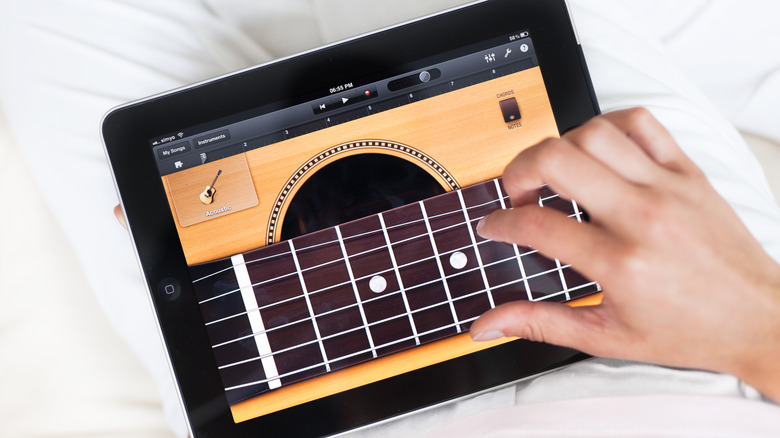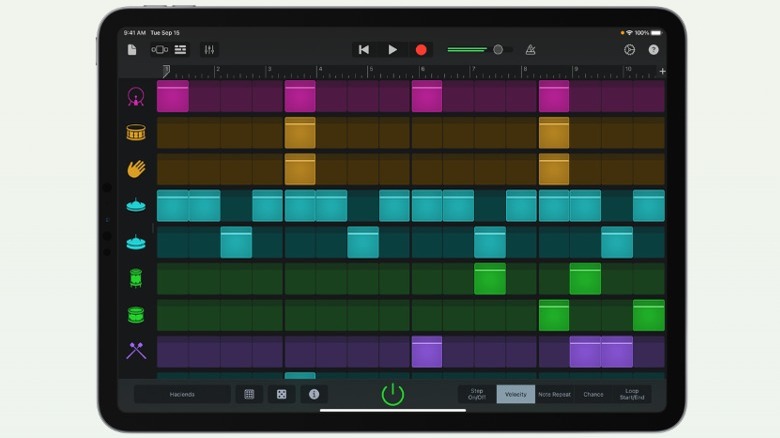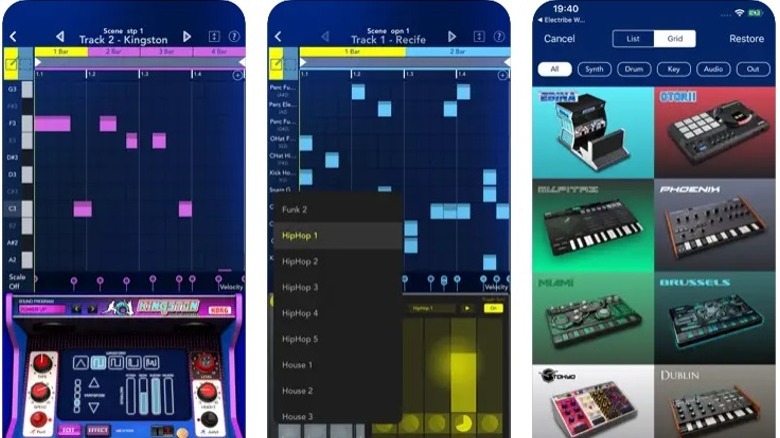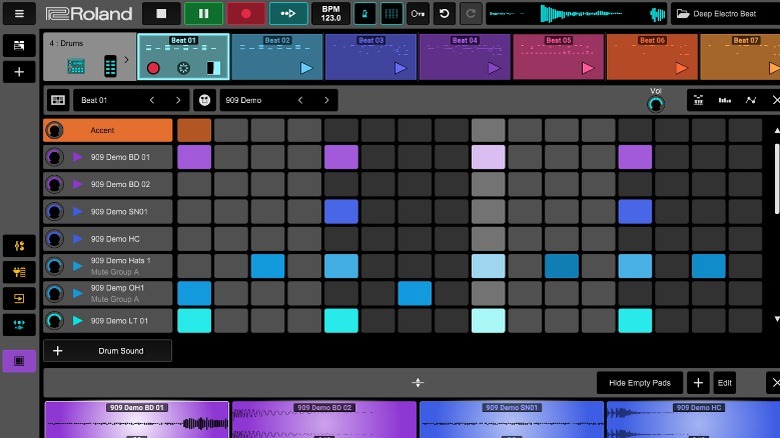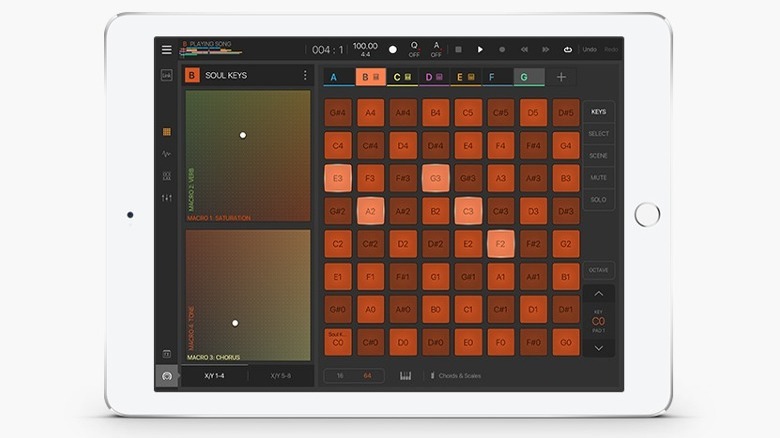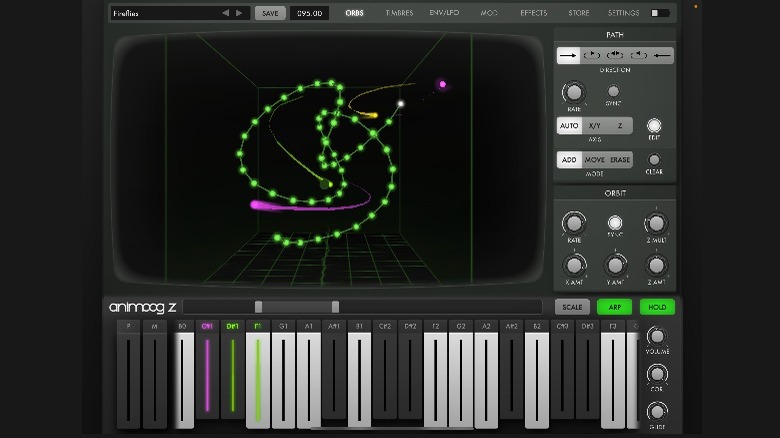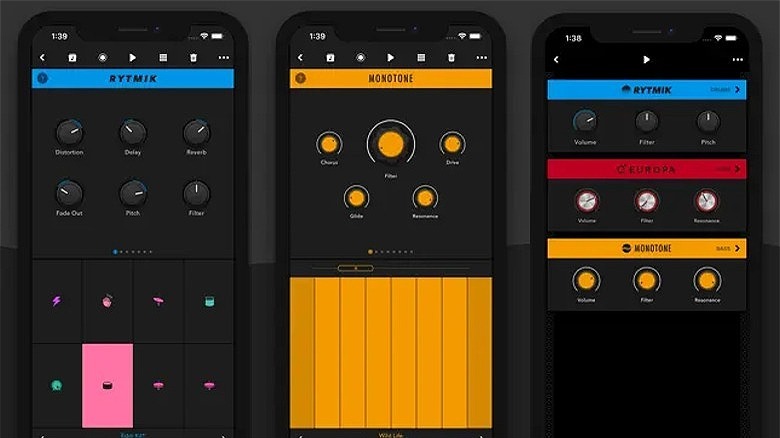6 Of The Best Apps For Making Music On Your iPhone Or iPad
The digitalization of instruments has made expensive music equipment more accessible than ever, democratizing music production for the masses. Recording, sequencing, and audio editing can now be executed on nearly any capable device, taking music production out of exclusive studios and into the hands of creatives everywhere.
Meanwhile, the miniaturization of technology and the ubiquity of smartphones means that this technology isn't just at your fingertips while you are sitting at a desk with your MacBook. Instead, it's readily available in your pocket or backpack thanks to various music-making apps you can find for your iPhone or iPad. Aspiring producers have an abundance of tools at their disposal, and you can use them while sitting in a coffee shop or waiting for a train.
From virtual synthesizers and drum pads to fully featured digital audio workstations and sequencers, the tools that are just a click away on the App Store are pretty impressive. If you are interested in creating songs using little more than your phone and a little creativity, check out these six great apps for making music on your iPhone or iPad.
GarageBand
The best place to start if you want to make music on your iOS device is GarageBand. Beyond being a reliable tool on Mac users' desktops since the early 2000s, the iOS version of GarageBand has been tailored for iPads and iPhones for over a decade. This extensive optimization means that the app is intuitive to use while being well-adapted to both the freedoms and constraints of mobile devices.
Garageband presents you with an easy-to-navigate studio interface where you can apply different layers of instrumentation to create fully featured songs composed of up to 32 separate tracks. An expansive sound library allows you to access a variety of loops, pre-recorded drum sessions, and royalty-free sounds from artists such as Dua Lipa that are provided in Producer Packs. Alternatively, users can input their compositions using the suite of included Touch Instruments that replicate guitars and synthesizers, while percussion elements can be created using a beat sequencer or an electronic drum pad.
The biggest strength of GarageBand lies in its longtime presence on iOS devices and its seamless integration into the Apple ecosystem – although this can be somewhat limiting if you hope to collaborate with others outside of the Apple bubble. At the end of the day, however, GarageBand is a relatively easy-to-use tool that is not only free to access for all iPhone and iPad owners but is likely already installed on your device. If not, you can grab it from the App Store.
Korg Gadget 2
If you are looking for an iOS app for making music that isn't quite so tied into the Apple ecosystem, you might want to check out Korg Gadget 2. This tool — created by the legendary Japanese electronic instrument manufacturer whose iconic line of Korg synthesizers can be heard on songs by artists like Daft Punk – allows you to access studio-quality sounds in an easy-to-use interface right from your mobile device.
The signature feature of this app are the titular Gadgets, which are reproductions of over 40 different electronic instruments and tools ranging from synthesizers to drum machines to guitar effect processors. These range from straightforward keyboard kits like the Salzberg and Montreal electronic pianos to specialized instruments such as the Miami dubstep wobble synthesizer and the Chicago tube bass machine. Beyond that, a partnership between Korg, Sega, and Taito has resulted in the Otorii 16-bit drum machine and the Ebina arcade synthesizer, allowing you to recreate the sounds of your favorite video game soundtracks.
All of the music you create using these gadgets can be recorded and tracked into the app's digital audio workstation interface, and any work done there can be shared with the desktop version through iCloud, Korg Gadget 2 for Nintendo Switch, and even other Korg products such as the popular performance software Ableton Live. In fact, the Gadget plug-ins themselves can even be used with compatible digital audio workstations on the PC. All of this flexibility comes at a price, however – Korg Gadget 2 costs $39.99 on the App Store.
Roland Zenbeats
If you are looking for something to work with something even more powerful than a relatively straightforward digital audio workstation, another great iOS app to check out is Roland Zenbeats. This app comes from another legendary Japanese electronic instrument company – Roland – whose iconic TR-808 drum machine can be heard on tracks from Marvin Gaye, Whitney Houston, and the Beastie Boys.
Roland Zenbeats includes patches for a huge variety of 808 sounds and many of their other iconic drum kits, including the TR-909. Beyond that, the app has access to Roland's massive library of more than 14,000 presets alongside the app's extensive collection of samples and loops. In addition, features such as the ZC1 virtual synthesizer and LoopBuilder allow you to input beats and create your own loops.
While these tools make Roland Zenbeats an enticing download for anyone looking to experiment with a diverse collection of sounds, many of these sample packs and presets either require an individual purchase in the in-app store, a one-time iOS unlock fee of $14.99, or a subscription to the Roland Cloud, which starts at $2.99 per month.
However, even the free download of Roland Zenbeats from the App Store gives you access to an app that can essentially serve as a fully featured production studio right from your mobile device. Beyond that, Roland's cross-compatibility options are even more robust than many of its competitors, with options for desktop versions of the same software as well as compatible Android apps. If you work with other musicians or band members to compose your tracks, Roland Zenbeats might be your best option.
Beatmaker 3
Of course, not everyone looking to make music on their iPad needs the full capabilities of a cross-platform music studio to bring their ideas to life. Sometimes, an overwhelming amount of options – with its inevitably steep learning curve – can be more daunting than helpful, especially for beginners. If you're searching for a music-making app with an inherently easy-to-use interface, Beatmaker 3 deserves your attention.
Designed as an iPad exclusive from the ground up, Beatmaker 3 offers an intuitive design catered to touchscreen controls that reveal a capable array of music production tools. Most importantly, its standout features are designed to help you take your own sounds and arrange them in a clean, professional-sounding package. For instance, the app's signature Beatmaker pads can be configured in a drum machine pattern, supporting up to 16 pads across eight banks, which means that it can be programmed with up to 128 sounds. Likewise, a keyboard sampler can be set up with 128 keys, each of which can be modulated on the fly with a pitch wheel and other modifiers.
Once you have the sounds you want ready and recorded, you can quickly slot them into a multi-track sequencer to arrange your compositions. Full sample editing tools allow you to further finetune any individual elements to make your music come across exactly how you intended, all of which is controlled by intuitive touchscreen input. However, while Beatmaker 3 shares GarageBand's ease of use, it diverges in pricing –- it will cost $26.99 to download Beatmaker 3 on the App Store.
Animoog Z Synthesizer
If you want to turn your iPhone or iPad into an easily playable and adjustable instrument, then Animoog Z might be more to your tastes. The original Animoog was one of the first apps to demonstrate that Apple devices could be repurposed into professional-grade synthesizers all the way back in 2011, and the tech behind the Animoog Z has only gotten better since.
The legacy of this decade-old app is noteworthy, but the history of the company behind it, Moog, is even more important. The Moog synthesizer has been described as the first commercially available synthesizer, and it was used by massively influential bands like The Beatles and Kraftwerk. Animoog Z is, at its core, a polyphonic synthesizer that doesn't just replicate the experience of playing a physical Moog keyboard but instead uses some of the same technology to act as a fully capable instrument in its own right.
An extensive library of timbres allows you to play with sounds honed over decades, while the timbre editor enables precise modulation of the synthesizer to create your desired soundscape. Animoog Z elevates this experience by introducing a Z-axis to the synthesizer's visual orbit path, offering a three-dimensional view of the sound generation process.
While Animoog Z doesn't include the sequencing tools included with many contemporary iOS music apps, it can record and loop performances and is compatible with other apps, including GarageBand. If you are looking for a tool that will allow you to start making professional-grade sounds with a minimal learning curve, download the Animoog Z Synthesizer on the App Store.
Reason Compact
Somewhere between the ambitious approach of a full-featured yet mobile production studio and the more minimal standalone digital synthesizer apps sits Reason Compact, a slimmed-down version of the well-known desktop studio that allows artists to quickly record ideas. This is an excellent app for anyone looking for a mobile version of a professional toolset, although certain design constraints may mean it's not the right choice for everyone.
The desktop version of Reason is a digital audio workstation best known for its unique virtual equipment rack, in which individual digital instruments, amplifiers, and modulators can be virtually plugged into one another to emulate a physical studio setup. Once the instruments are configured, Reason facilitates sequencing, editing, and mixing the resulting sounds to create full tracks.
Reason Compact repackages some of these digital instruments into a more compact form, allowing you to quickly jot down musical ideas on the go. The app includes signature instruments such as the Europa synthesizer, the Monotone Bass Synthesizer, and the Rytmik drum machine. It also provides a drum pad and keyboard to play each of these components, with additional instruments available to be purchased in-app.
The most significant advantage of Reason Compact is that it gives users access to professional quality digital instruments at no initial cost, as the app can be downloaded for free from the App Store. However, the biggest disadvantage of Reason Compact is that it requires access to a more robust digital audio workstation – ideally Reason itself – to truly unlock its full potential. Still, as a free download, aspiring iPhone producers could do much worse.
